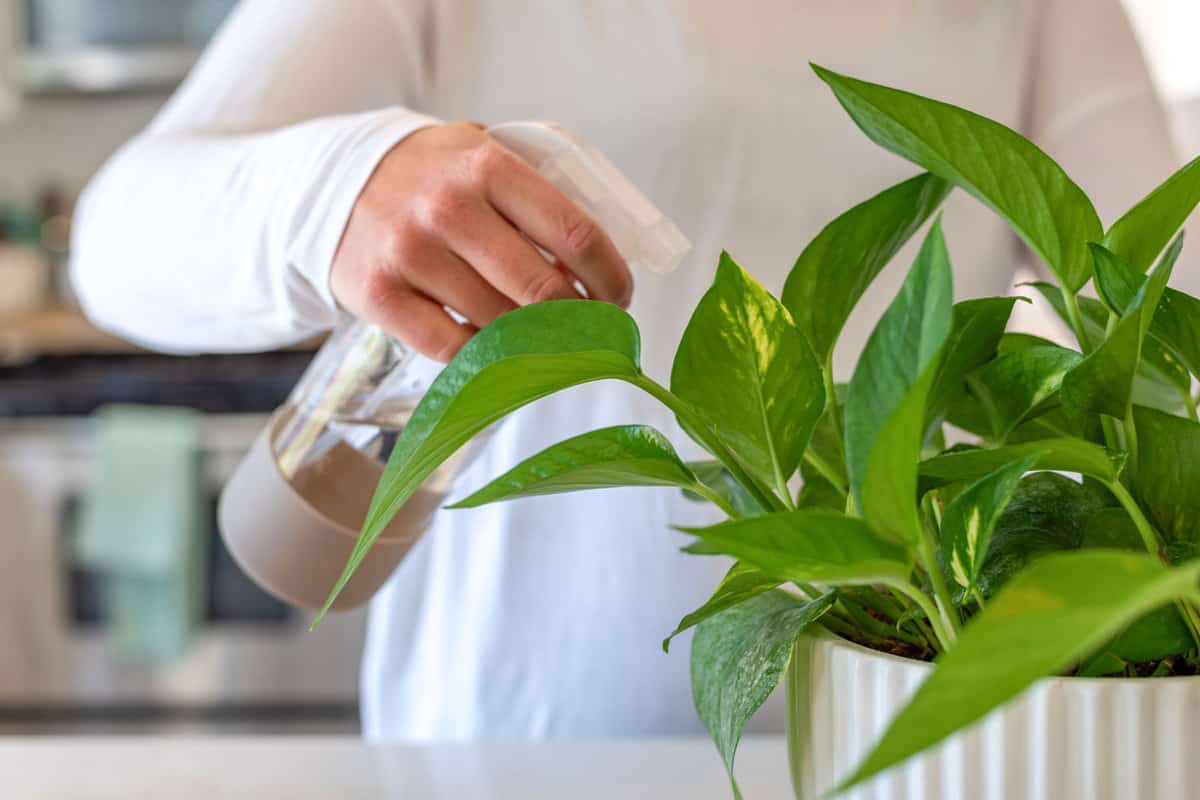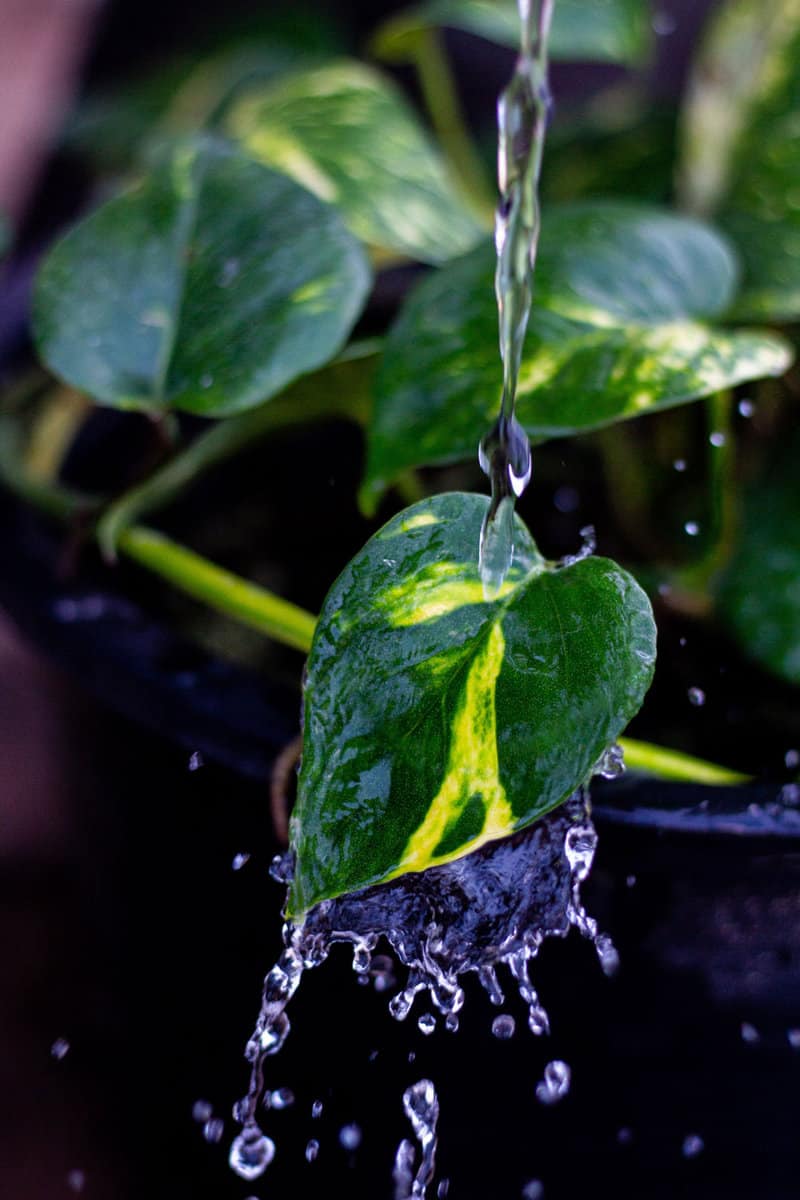Pothos plants are popular houseplants known for their beautiful heart-shaped leaves and easy-to-grow nature. They thrive even in low light and need minimal watering.
However, to guarantee your pothos remains vibrant, it's vital to recognize its watering preferences. These can vary depending on soil, sunlight, humidity, and growth season.

While they might need more water in sunny, warm conditions, the colder winter months demand less.
Instead of a rigid watering schedule, keep an eye on the soil's moisture, as local conditions can alter the plant's needs.
By understanding the specific watering needs of your pothos plant, you can promote its optimal growth and enjoyment.
Ideal Watering Conditions for Pothos
Understanding these requirements can help in nurturing a thriving and vibrant pothos plant.

Here's a guide to the ideal watering conditions for pothos.
Preferred Water Temperature
Pothos plants thrive when watered with lukewarm water. Using water that is too cold can shock the plant and may lead to stress, causing leaf discoloration.
It's better to avoid hot water as well, as it could potentially damage the plant's delicate roots.
Preferred Water Quality
Pothos are not too picky when it comes to water quality. They can tolerate tap water; however, it's best to use filtered or distilled water to avoid the buildup of minerals and chemicals found in tap water.
If using tap water, let it sit for 24 hours to allow chlorine to dissipate before watering your pothos.
The water you use should be free of contaminants, as they can damage the plant's overall health.
During the growing season, usually warmer months, pothos may require more frequent watering.
Humidity plays a role in the pothos' watering needs, as they enjoy higher humidity levels.
If your home has low humidity, consider using a humidifier or placing a tray of water close to the plant to enhance the air's moisture content.
Adjusting Watering Practices for Seasons
Pothos plants have different watering requirements depending on the season.
Adequate watering practices help keep them healthy and thriving. In this section, we will discuss the specific needs of pothos during the summer and winter seasons.
Summer Requirements
During the warmer months, pothos plants require more frequent watering sessions.
It is common to water them once a week in the summer season. The increased temperature and humidity can lead to faster evaporation, leaving the soil drier.
Monitor the soil's moisture, checking the top inch for dryness before watering.
Avoid overwatering, as this can cause root rot and other water-related issues.
To maintain proper drainage, plant your pothos in a pot with drainage holes and use a well-draining potting mix.
This will prevent excess water buildup, ensuring that the plant receives the right amount of water without becoming waterlogged.
To learn more about pothos' soil mixture, check out this article: Soil, Repotting, And Fertilizing Needs For Pothos
Winter Requirements
In contrast, pothos plants require less frequent watering during winter months. It is usually enough to water them once every two weeks in this season.
The decreased sunlight and lower temperatures result in slower evaporation rates, keeping the soil moist for a longer duration.
Always check the soil for moisture before watering. You can do this by touching the soil with your index and middle fingers.
If the soil is still moist, it's best to wait before adding more water. This will ensure that the pothos receive the appropriate amount of water to stay healthy and vibrant during the colder months.
Common Mistakes in Watering Pothos
Two common mistakes that people often make while watering their pothos plants are overwatering and underwatering.
Overwatering
Overwatering is a typical mistake made by beginners who assume that pothos, being a tropical plant, needs frequent watering.
When a pothos plant is over-watered, its roots can suffocate, leading to root rot and a host of other problems.
To avoid overwatering, always wait until the top 2–3 inches of soil dry out before adding more water.
Keep in mind that the plant's watering needs may vary depending on the season, climate, and potting media.
A few signs that your pothos may be over-watered include:
- Yellow leaves
- Wilting despite adequate moisture
- Mold on the soil surface
You might also like to read: Pothos Leaves Turning Black- What To Do?
Underwatering
The other extreme, underwatering, can also harm your pothos plant.
Waiting too long between watering sessions, not providing enough water, or using a poorly draining pot can lead to dehydration and stunt the plant's growth.
A well-hydrated pothos will have lush, vibrant foliage. Always aim to strike the right balance by watering the plant only when the soil has dried out.
Some symptoms of underwatering include:
- Brown, crispy leaf edges
- Drooping leaves
- Slow or stunted growth
Remember that while pothos plants are quite forgiving, it's important to avoid overwatering and underwatering to keep your plant looking its best.
Finding the right balance will ensure lush, vibrant greenery that can thrive and flourish.
Utilizing Moisture Meters for Pothos
While measuring soil moisture with your fingers is a traditional method, using a moisture meter can offer a more precise and reliable approach.
Employing moisture meters for pothos plants brings forth a host of benefits:
Accurate Measurement
Moisture meters deliver precise readings of the soil's moisture content. This accuracy means your plant gets the right amount of water, helping to prevent both overwatering and underwatering.
Consistency
With regular checks using a moisture meter, you can establish and maintain a consistent watering routine tailored to the specific needs of your pothos.
Adaptability and Scheduling
Changes in environmental factors such as humidity and light levels can influence how often you water your plant.
Moisture meters not only help you recognize these changes but also allow you to adjust your watering schedule that accounts for these factors, ensuring your pothos remain healthy in varying conditions.
Click here to see this Soil Moisture Meter on Amazon.
Effects of Proper Watering
Let's explore the impact of ideal watering on the growth and leaf health of your pothos.
Growth Impact
Giving your pothos the correct amount of water promotes healthy and steady growth.
Watering every 1–2 weeks, allowing 2–3 inches of the soil to dry out between waterings, encourages proper moisture levels for the plant's roots to absorb vital nutrients and develop optimally.
By following the appropriate wet-dry moisture cycles, you mimic the natural rainfall patterns from the tropical climate where pothos evolved, helping it to grow strong and sturdy.
Leaf Health
Proper watering management not only affects the growth of the pothos but also contributes significantly to leaf health.
Overwatering can lead to yellowing leaves and black stems while underwatering can result in wilting and dry potting mix.
Keeping the soil evenly moist helps prevent common underwatering symptoms like yellow leaves, wilting with dry soil, and brown leaf edges.
To maintain healthy leaves, check your pothos' soil moisture regularly.
A simple method is to touch the soil with your index and middle finger; if the soil is dry, it's time to water.
Alternatively, employing a moisture meter can provide a more precise measurement of the soil's moisture content, guiding you on when to water.
If the soil remains moist, hold off on watering until it dries out more.
Paying attention to your pothos' water needs not only maintains the vibrancy of its foliage but also contributes to the overall well-being of the plant.
From Novice to Pothos Pro: Watering Takeaways for Success
Navigating the intricacies of watering pothos plants can seem daunting, but with proper understanding and a little vigilance, it becomes a rewarding experience.
Recognizing the plant's seasonal requirements, using tools like moisture meters, and remaining attuned to the plant's signals are all part of a holistic approach to plant care.
By ensuring the right balance between under and overwatering and adjusting routines based on environmental changes, you'll foster a thriving pothos that adds beauty and charm to your living space.
With the right knowledge and care, your pothos will not only survive but flourish, bringing a touch of nature's elegance into your home.

